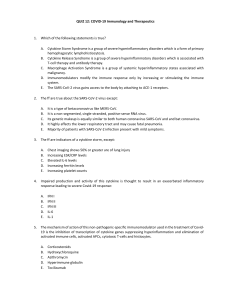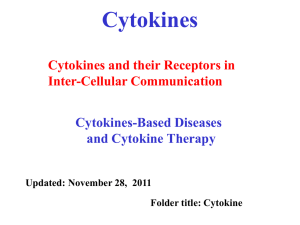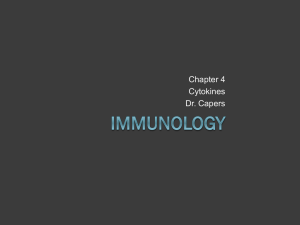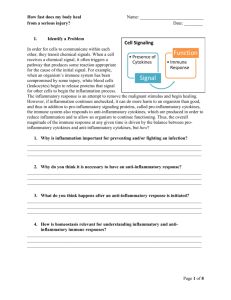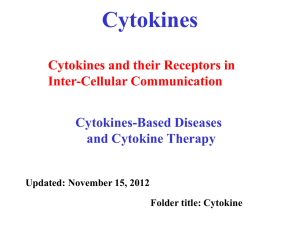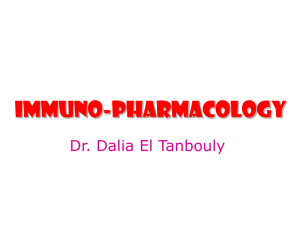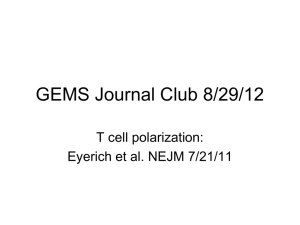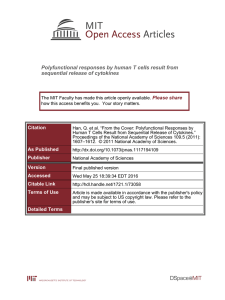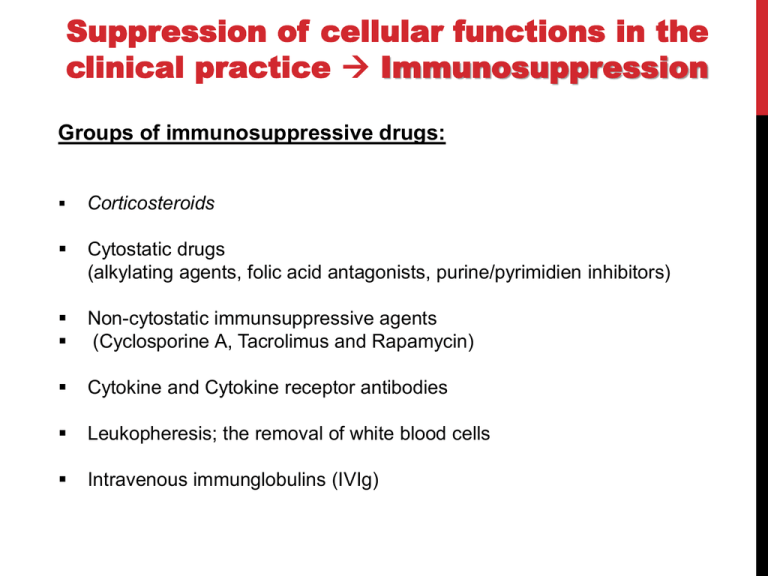
Suppression of cellular functions in the
clinical practice Immunosuppression
Groups of immunosuppressive drugs:
Corticosteroids
Cytostatic drugs
(alkylating agents, folic acid antagonists, purine/pyrimidien inhibitors)
Non-cytostatic immunsuppressive agents
(Cyclosporine A, Tacrolimus and Rapamycin)
Cytokine and Cytokine receptor antibodies
Leukopheresis; the removal of white blood cells
Intravenous immunglobulins (IVIg)
Indications for immunosuppression
Inflammation (dermatology, pulmonology, rheumatology)
Allergic diseases
Autoimmune diseases
Transplantation
CORTICOSTEROIDS I
Are apolar steroid hormones with broad biological effects. Able to penetrate the cell
membrane and bind glucocorticoid receptors (GRs) in the cytosol. The newly
formed receptor-ligand complex translocates to the nucleus where it binds
glucocorticoid response elements (GRE) in the promoter region of different target
genes.
Transactivation Up-regulating the expression of anti-inflammatory cytokines.
Transrepression Preventing translocation of pro-inflammatory transcription
factors and cytokines repressing their expression (Ex. NF-κB, AP-1, IL-1β, IL-2, IL-4,
IL-8, TNF-α etc. ).
Inhibiting leukocyte adhesion, migration, chemotaxis,
phagocytosis and cytokine secretion
CORTICOSTEROIDS II
Very important anti-inflammatory mechanisms of corticosteroids are the inhibition of
phospholipase A2 directly and indirectly (by synthesizing lipocortin-1; a PA2 inhibitor) and,
the inhibition of cyclooxygenases (like NSAIDs).
Inhibition of the arachidonic acid pathway decreases the pro-inflammation
mediators prostaglandins (PGE2 for example) and leukotrienes (LTs).
In addition as does endogenous cortisol:
↓ proliferation and differentiation of mast cells
↓ platelet activating factor
↓ NO production
↓ number of circulating T cells
↓ interleukin production
↓ IFN-γ production
CORTICOSTEROIDS
RELIABLE EFFECTS & RELIABLE SIDE EFFECTS
- Central obesity
- Growth reatardation in childhood
- Susceptibility to infections
- Increased risk of thrombosis, coronary heart disease
- Lengthened wound healing, ulcers
- Gastric ulcer
- Osteoporosis, aseptic bone necrosis
- Hypertension
- Hirsutism (excessive hairiness), atrophy of skin
- Glaucoma, cataract
Strict dose limitations, alternating dosage, gradual dose decreasing!
Local administration: fewer (not as significant) side effects!
IMMUNOSUPPRESSIVE DRUGS
CORTICOSTEROIDS
Prednisolone
Methylprednisolone
Triamcinolone
betamethasone
Budesonide
CYTOSTATIC DRUGS
Agents for tumor therapy can inhibit the proliferation of lymphocytes.
Effective alongside aggressive and severe side effects.
Alkylating agents (Cyclophosphamide, Chlorambucil)
• Bind to guanine nucleotides, inhibiting DNA-replication;
• Effective, but causes severe leukopenia and lymphopenia. Anticancer treatment while for
autoimmune disorders purine antagonists are prescribed more often.
Folic acid antagonists (Methotrexate)
• Inhibition of nucleotide synthesis (Folic acid dependent)
• Hepatotoxic, so regular checks of liver enzymes are needed!
Purine antagonist drugs (6-mercaptopurine, Azathioprine and
Mycophenolate mofetil)
T- and B-cells have no runaround scavanger recovery pathway, they can
produce purine nucleotides through de novo pathway.
IMMUNOSUPPRESSIVE DRUGS
CYTOSTATIC DRUGS
Azathioprine
Mycophenolate
mofetil
Methotrexate
Cyclophosphamide
NON-CYTOSTATIC
IMMUNOSUPPRESSIVE DRUGS:
Cyclosporin A. Cyclic peptide of 11 amino acid that binds cyclophylin, a
cytosolic protein. This complex of cyclosporin and cyclophylin prevents the
activation of calcineurin that is responsible for activating IL-2 transcription factor
NF-AT.
Tacrolimus (FK506). Large cyclic compound that acts like the cyclosporin but on
different cyclophillin (FKBP-12).
Rapamycin (Sirolimus) binds FKBP-12, but this complex acts on an other
serine/threonine phosphatase (mammalian target of rapamycin or "mTOR" =
PP2A), not on calcineurin (PP2B).
Used in transplant medicine to prevent rejection, psoriasis, atopic dermatitis, arthritis
and related diseases.
* Cyclophilin is an isomerase catalyzing trans to cis isomeration od peptides during protein folding.
Cyclosporin A and tacrolimus (FK506) inhibits cell
activation by neutralyzing the serine/threonine
phosphatase calcineurin
IMMUNOSUPPRESSIVE DRUGS
NON-CYTOSTATIC DRUGS ACTING ON T CELLS
Tacrolimus
Cyclosporin A
Rapamycin (Sirolimus)
CYTOKINE AND CYTOKINE
RECEPTOR ANTIBODIES:
Cytotoxic and blocking monoclonal antibodies (MAB) targeting
different cytokines or receptors.
MAB targeting CD3 on the surface of T cells. Transplant medicine.
many more tagets…CD4, CD2, CD7, CD20, CD25 HLA-D, IL-17, IL-23, IL-6.
MAB targeting TNF-α used for autoimmune disorders like RA and IBD Infliximab and
Adalimumab.
MAB targeting IL-2 used for preventing transplant organ rejection Basiliximab and
Daclizumab.
MAB targeting IgE used for allergic asthma Omalizumab.
Act by either blocking different receptors inhibiting cell function, or opsonizing
the targeted cells activating complement pathways resulting in phagocytosis.
IMMUNOSUPPRESSIVE DRUGS
MAB TARGETING CYTOKINES OR CYTOKINE RECEPTORS
Basiliximab
Daclizumab
Infliximab
Omalizumab
LEUKOTRIENE PATHWAY
INHIBITION:
Used as prophylaxis for asthma. Improve asthma control and reduce frequency of
exacerbations.
Leukotrienes are arachidonic acid derivatives synthesized by inflammatory cells in
the airway (eosinophils, mast cells, macrophages and basophils).
LTB4 chemoattractant
LTC4 and LTD4 increase bronchial reactivity, constriction, mucosal edema and
mucus secretions.
Zileuton inhibits 5-lipooxygenase.
Zafilukast and Montelukast are LTD4 receptor antagonists.
IMMUNOSUPPRESSANT DRUGS
LEUKOTRIENE ANTAGONISTS
Montelukast
Zafirlukast
Zileuton
OTHER IMMUNOSUPPRESSIVE
AGENTS:
Fingolimod (FTY720) Acts on adhesion molecules (α4/β7 integrin)
on lymphocytes causing their accumulation in the lymph nodes, rather than
the peripheral circulation, preventing their movement into the CNS.
Reduce relapses and delay disability progression in patients with relapsing
forms of multiple sclerosis (MS).
Glatiramer acetate Prescribed for MS. Reduces the
frequency of relapses but not he progression of disability.
Mechanism not fully known. Th1 Th2 shifting ?
diverting the autoimmune response against myelin.
TREATING INFLAMMATION:
Goals:
1) Pain reliefe
2) Slow or arrest tissue-damaging processes
NSAIDs
Aspirin
DMARDs
Corticosteroids
NSAIDs have analgesic and antipyretic effects, but its their anti-inflammatory action
that makes them useful in management of disorders where pain is related to the
intensity of an inflammatory process (rheumatic disease for ex.)
NSAIDs mechanism of action:
1. Inhibiting prostaglandin synthesis
2. Inhibiting chemotaxis
3. Downregulation of IL-1 expression
4. Decrease free radicals and superoxides
IMMUNOSTIMULANTS:
Imiquimod (Aldara©)
Used in creams for some skin conditions and cancers. A TLR7 stimulator
ctivating Langerhans cells (skin DCs), macrophages and B cells, resulting in the
production of IFN-α, IL-6 and TNF-α. In addition to an anti-proliferative effect.
(secondary to surgery)
Echinacea species
Widely marketed but rather controversial (lack of well-controlled trials, with
many studies of low quality)
MYELOID GROWTH FACTORS:
Stimulate proliferation and differentiation of myeloid stem cells. Used in
transplantation.
Recombinant human G-CSF (Filgrastim) increase stem cells mobilization to the
periphery (↑ peripheral blood stem cells PBSCs) and stimulates the neutrophil lineage.
and GM-CSF (Sargramostin) stimulates early and late granulocytic progenitor cells
(as well as erythroid).
GM-CSF + IL-2 ↑ T cell proliferation.
Used to treat neutropenia after cytotoxic chemotherapy and after stem cell
transplantation.
Cytokines applied in therapy
Cytokine
Disease
Interferon-
Hairy cell leukaemia
Chronic Myeloid Leukemia
Melanoma
Kaposi sarcoma
Hepatitis B, C
Renal carcinoma
T-cell leukemia
(IFN- - type I)
(IFN- - type I)
Multiple sclerosis
(relapse-remission)
Interferon-
Chronic granulomatous disease
Interferon-
(IFN- - type II)
IL-2
Metastatic renal carcinoma
GM-CSF
Bone marrow transplantation stem cell
mobilization
Supportive therapy in oncohematology
Side effects
fever, influenza-like
symptoms, weight
loss, tiredness



